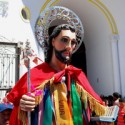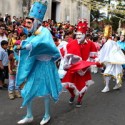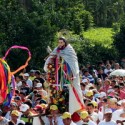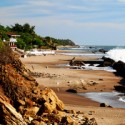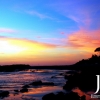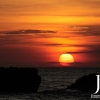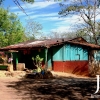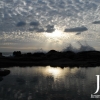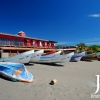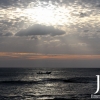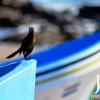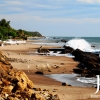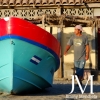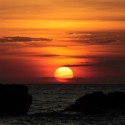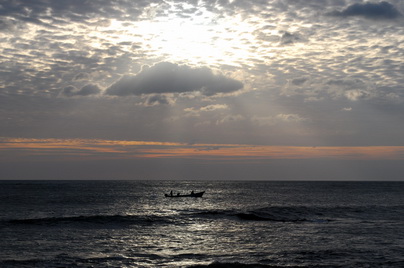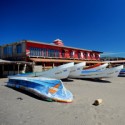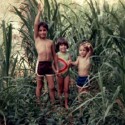Author Archives: admin
Ir a traducción en Español
Author: Dr. Armando Luna Silva
Photography by: Jimmy Mendieta
Translation by: Alejandra Palacio/Jeffrey Mendieta
Dr. Armando Luna Silva tells of a miracle Santiago performed enabling a girl's recovery from a child’s paralysis.
Apostle Santiago, Patron Saint of Jinotepe
Ir a traducción en Español
Author: Dr. Armando Luna Silva
Photography by: Jimmy Mendieta
Translation by: Claudia Vallejos/Jeffrey Mendieta
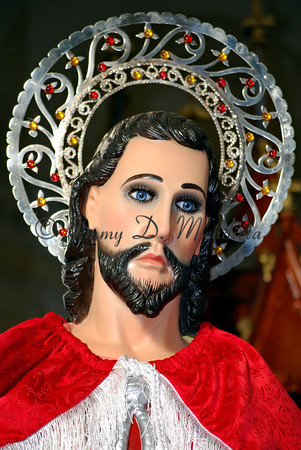 Amidst the Nicaraguan land, Jinotepe rises. This noble city is a bundle of friendship and cleanliness. Against its skyline, the towers of the Parish Church rise like a Titan’s arms that guard the image of the Apostle Santiago, Patron Saint of the city. Friar Pedro Agustín Morel de Santa Cruz visited Jinotepe in 1751. In his visit report he describes the people and its Church, and while addressing the people he says: “Santiago is entrusted to you”.
At the start of the century, the good people of the town of Jinotepe felt a nocturnal passion for the stories of apparitions, hauntings and penitent souls. Its dusk was frightful. Lax and unhurried. The shadows came slowly and it was then when ghosts would gain added mobility. In the closed nights of never ending rain, when the ghosts invaded the crevices of the town and the superstitious lighting traversed through the street, the elderly maid of the home would gather the children near the fire burning stove to tell them terrifying tales. And before the astonished gaze of the children and their suspense filled breaths paraded “la carretanagua”, “la cegua”, “la lutuda”, “el cadejo”,… Continue reading
Amidst the Nicaraguan land, Jinotepe rises. This noble city is a bundle of friendship and cleanliness. Against its skyline, the towers of the Parish Church rise like a Titan’s arms that guard the image of the Apostle Santiago, Patron Saint of the city. Friar Pedro Agustín Morel de Santa Cruz visited Jinotepe in 1751. In his visit report he describes the people and its Church, and while addressing the people he says: “Santiago is entrusted to you”.
At the start of the century, the good people of the town of Jinotepe felt a nocturnal passion for the stories of apparitions, hauntings and penitent souls. Its dusk was frightful. Lax and unhurried. The shadows came slowly and it was then when ghosts would gain added mobility. In the closed nights of never ending rain, when the ghosts invaded the crevices of the town and the superstitious lighting traversed through the street, the elderly maid of the home would gather the children near the fire burning stove to tell them terrifying tales. And before the astonished gaze of the children and their suspense filled breaths paraded “la carretanagua”, “la cegua”, “la lutuda”, “el cadejo”,… Continue reading

Copyright 2012 Jimmy Mendieta. All rights reserved.“This is the image of Santiago that by the streets of the Jinotepen July strolls its wondering gaze of marine horizon, searching in the neighborhood’s and street corners what he there did not lose: a green bell of algae, like born from the sea, with a twang like a marimba that only knows how to cry. It’s a prodigious image of strength and tenderness; its face is the loneliness, the space, the distance, it’s the prow that survives in the clarity of the waters”. Dr. Armando Luna Silva
Photos of “El Tope de Santiago”
Ir a traducción en Español
It is in the modest parrochial church of the "Virgen de los Dolores" (Virgin of Sorrows), where the traditional "Tope de los Santos" (meet up of the Saints) is celebrated, which is popularly known simply as "El Tope". This collection of photos is of the "Tope de Santiago" which took place in July of 2012. All photos are property of Jimmy Donald Mendieta.
http://www.photosofnicaragua.com/Photography-by-Jimmy-Mendieta/Festivals-of-Nicaragua/El-Tope-de-Santiago-Jinotepe/24397796_4T6Xhh
© Jimmy D. Mendieta. All rights reserved.
Photos of Casares, Nicaragua
Ir a traducción en Español
A collection of photos of Casares Beach and its batheing areas. All photos are property of the photographer, Jimmy Donald Mendieta and are available for purchase. There are various print sizes available at http://www.photosofnicaragua.com/buy/23693969_2xMGXX/.
© Jimmy D. Mendieta. All rights reserved.
Casares the Chief Navigator
Ir a traducción en Español
Author: Dr. Edmundo Mendieta Gutierrez
Photography: Jimmy D. Mendieta
Translator: Jeffrey G. Mendieta
In an interview with El Diario La Prensa, Dr. Edmundo Mendieta Gutierrez tells the legend of how Casares Beach got its name.
The legend tells that in coastal lands in Carazo in a village dotted with thatched huts sheltered by palm trees, guanacastes and lush tamarinds. there lived the chief Casares. The chief Casares was a wise indian who, like San Francisco of Asis, talked to all the creatures of Heaven and Earth. One afternoon he led his tribe to the seashore and there said to them, "From across the ocean have come perverse men who will try to destroy our gods, we must learn to navigate the sea to save us and save our beliefs.”
Right away all the members of the tribe dedicated themselves to build a giant pirogue in which they deposited their manuscripts, sacred idols and plenty of food. When the Spanish arrived, they could still see out from the shore, the giant pirogue in which the indians sailed to sea, singing to the beat of a kettledrum inherited from their ancestors. It is unknown what became of Casares and its people. They say that on the nights of a full moon, the canoe can still be seen silhouetted against the Moon. At midnight the shadows of the members of the tribe disembarc on the beach, and sing to the beat of the cheif's tom-tom drum, a long sad love song.
(Dr. Edmundo Mendieta, tomado del Diario La Prensa el diario de los Nicaraguenses)
The Founder of Casares Beach
Ir a traducción en Español
Author: Dr. Edmundo Mendieta Gutierrez
Contributer: Jimmy D. Mendieta
Photography: Jimmy D. Mendieta
Translator: Jimmy D. Mendieta
This story was told by Don Crisanto to my uncle Edmundo when he was only 15 years old, in the beach of Casares. Dr. Edmundo Mendieta Gutierrez, married the granddaughter of Don Crisanto, Mrs. Daisy Briceno de Mendieta. It is the story of how my great-grandfather Crisanto Briceño (father of my grandmother Mrs. Ernestina Briceño) is the founder of this beautiful beach of Casares.
My uncle Dr. Edmundo Mendieta Gutierrez writes...
“The moon of March, a mystical moon in various regions and religions of ancient peoples, as its full moon was the closest to the spring equinox and therefore the precursor of green fields and flowering of trees, as well as warm temperatures inviting swimming in the beaches and rivers. The diriambinos, were no strangers to this influence, which was considered more of an enchantment, which fortunately coincided with the completion of the harvesting and sale of the coffee crop, the main crop of the land. In this peaceful and quiet town of Diriamba lived a pretty young woman named Juanita Echaverry, to which two young men courted her, with the gentlemanly rivalry of that time. Both were of the best families and wealthy, but with a difference. While Enrique Granja, tall and elegant, with a large fortune, carelessly spending it by the hand full, Crisanto Briceno could not do the same, as even though he possessed a considerable fortune when he was orphaned, it was administered by an executor who gave money in instalments. Continue reading
The Little Pool
Ir a traducción en Español
Author: Jeffrey G. Mendieta
Photography: Jimmy D. Mendieta
I remember as a young boy when my family camped at the beach in Casares which is about a 30 minute drive from Diriamba. I was about 4 years old with sandy blond hair, fair skin, light brown eyes, a little pot belly and skinny little legs. We had a special little spot called “La Posíta” (The Little Pool). We called it “La Posíta” due to a rock formation which sectioned off a small pool like area where we could bathe safely. This photograph is of that exact location.
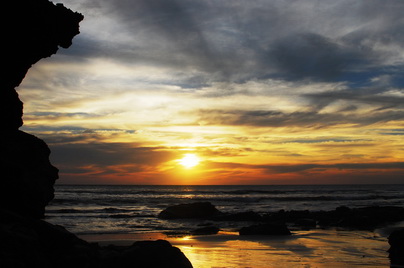 You can just make out the little pool in the center of the photograph where the rocks are just at the edge of the water.
Only about 100 feet away from “La Posíta” Papa Raul, my grandfather, owned a little beach house with a couple of small rooms, a kitchen with only the essentials and a small open space for sitting. The little beach house was made of large, rough, grey bricks cemented together. The windows were just metal rods each about half an inch thick laid out vertically, kinda like what you would see in a jail. No glass. Most of them were very rusty due to the humid, salty breeze coming from the sea. The floor was made of ceramic tiles but I can't remember the color. The doors were made of wood which was also old looking and very worn down and barely strong enough to keep people out when locked. Continue reading
You can just make out the little pool in the center of the photograph where the rocks are just at the edge of the water.
Only about 100 feet away from “La Posíta” Papa Raul, my grandfather, owned a little beach house with a couple of small rooms, a kitchen with only the essentials and a small open space for sitting. The little beach house was made of large, rough, grey bricks cemented together. The windows were just metal rods each about half an inch thick laid out vertically, kinda like what you would see in a jail. No glass. Most of them were very rusty due to the humid, salty breeze coming from the sea. The floor was made of ceramic tiles but I can't remember the color. The doors were made of wood which was also old looking and very worn down and barely strong enough to keep people out when locked. Continue reading

This photo is of the exact place. You can see “La Posita” in the center of the photo where the rocks at the edge of the water are. ©Jimmy D. Mendieta A. All rights reserved.

